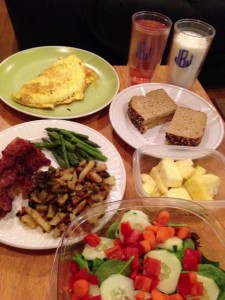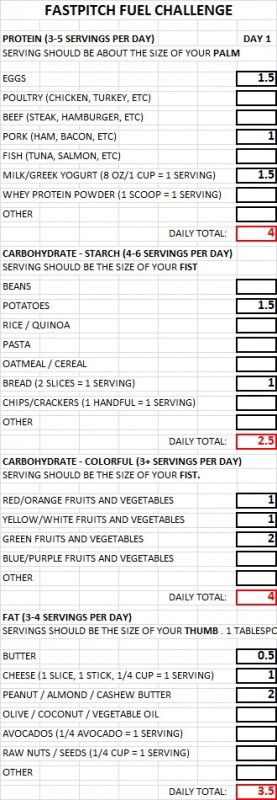Introducing Fastpitch FUEL: How to Eat Healthier
Summer break is either here or approaching for most athletes. Although Summer is certainly not considered the softball “off-season”, it is a great time for athletes and families to make HUGE steps toward improving your health and performance.
Not only should you have more time to plan workouts, you should be able to eat healthier now that you have a home-field advantage.
NO MORE:
- “I don’t have time for breakfast”
- “School food is gross”
- “I didn’t get to eat because I came right from school”
Summer is the perfect time to install and practice healthy eating habits. To be very clear, I KNOW how difficult upgrading your diet can appear to be.
When most people hear “diet”, they think:
- strict rules
- boring food
- expensive groceries
- impractical for families
- impractical when traveling
Probably worst of all, when people hear “diet”, they think about the number of other times they’ve tried a plan and failed.
That’s like going up to bat and thinking about striking out before the first pitch is delivered.
The Fastpitch Fuel Card
This week, I’m going to show you a way to become your own nutrition coach. At the bottom of this post, you will be able to access our Fastpitch Fuel Scorecard. Essentially, it is a chart that will help you monitor your diet decisions and make sure you’re eating the right amount of each food group.
I give you physical serving-size references (palm, fist, thumb) so you don’t have to worry about measuring your food. This is a trick I learned from Precision Nutrition.
I set a suggested range of servings per day for each food group. If you fall within these ranges 90% of the time GOOD THINGS WILL HAPPEN.
What about Grains, Gluten, and Dairy?
If you have a diagnosed intolerance to certain foods, then you will need to make food choices based on your individual prescription. I don’t recommend that people without diagnosed intolerance or allergies subscribe to wheat, gluten, dairy, or even sugar free diets.
Long story short, these types of “elimination” diets end up cutting a substantial amount of calories from an individual’s daily intake, and strategies like “Paleo” end up replacing a percentage of those calories with protein and/or fat while increasing fiber consumption from vegetables and fruit. So when an individual (without a diagnosed intolerance) sees improvements with a similar strategy, there are A NUMBER of possible reasons as to why. Somehow we like to hang our hat on only what we eliminated. But that’s a whole ‘nother bag of peanuts.
The Fastpitch Fuel Card doesn’t tell you what to eat, while it doesn’t demonize any foods either. It will allow you to monitor you intake, while encouraging balance and variety from whole food or single-ingredient sources. For athletes, this should also help you make better decisions when you’re at school as well.
How to use the Fastpitch Fuel Card
Simply make a tally mark next to the food group for everything you eat each day. If your portion resembles the physical serving-size reference I’ve provided, mark a 1. If it’s less, mark 1/2. If it’s more, mark 1.5 or 2. In the “Daily Total” box below each column, add your servings and see if they fall in the recommended range.
Individual Adjustment
A 130 pound softball player and 250 pound football player will have substantially different diets.
The Fastpitch Fuel Card provides the minimal, suggested serving ranges per food group for most young athletes and moderately active adults. There may be athletes or adults who are super active or actually struggle to keep weight or muscle on. Those individuals will need to consume a serving or two more protein, starchy carbs and fat.
My (Ridiculous) Example
Below is a picture of my dinner from last Friday. Holding aside judgement, the size of this meal serves as a great exercise in food record keeping. Below the picture I show you a screenshot of the Fuel Card and one column where I’ve recorded the components of this meal.
 One plate at a time, here’s how I broke it down:
One plate at a time, here’s how I broke it down:
- Omelet w/cheese cooked with .5 tablespoon butter – 1.5 serving protein, 1 serving fat, .5 serving fat
- Drinks: Crystal Light and 12 oz Milk – 1.5 serving protein
- Peanut Butter Sandwich – 1 serving carb, 2 serving fat (2 tbsp peanut butter)
- Pineapple – 1 serving yellow fruit
- Salad – 1 serving green vegetable, 1 serving red/orange
- Baked Homefries – 1.5 serving carb
- Asparagus – 1 serving green vegetable
- Bacon – 1 serving protein
Access and print your Fastpitch Fuel Card HERE

Hi Joe, just want say thanks for all the info and your passion for fitness and Fastpitch softball .
The fuel card example is for one meal ? And what should be daily totals per meal for 5’3 -135 pound female trying to get in optimum shape for summer travel/ college recruiting season ,
Thanks and wish you had place on Long Island .
Hi Brian,
Are you close to Glen Cove? I have a referral for you there.
The Fuel Card example is for one of MY meals last week. Friday night, post workout, leftovers + some things I whipped up. I typically eat lighter throughout the day and have to make up for it at night.
Daily Totals for a 5’3″ 135 pound female athlete
4 servings protein
4-5 servings starchy carb
3+ servings fruits and/or vegetables
3 servings fat
Here’s what that could look like:
Breakfast
1 cup Honey Nut Cheerios
1 cup milk (in cereal)
3 eggs scrambled
Lunch
2 pieces bread
1/3-1/2 lb sliced turkey
1 slice cheese
1 tbsp mayo
Afternoon
1 Bottle G2 Gatorade around practice
1 Banana
Dinner
1.5 palm burger
1 hamburger bun
Ketchup on burger (size of a quarter)
1 small fist carb (potatoes, pasta, rice, potato salad, pasta salad, etc)
2 fists vegetables (ex: 1 small spinach salad, 1 fist cooked vegetable)
Dessert
1 small fist ice cream (= 1 carb, 1 fat)